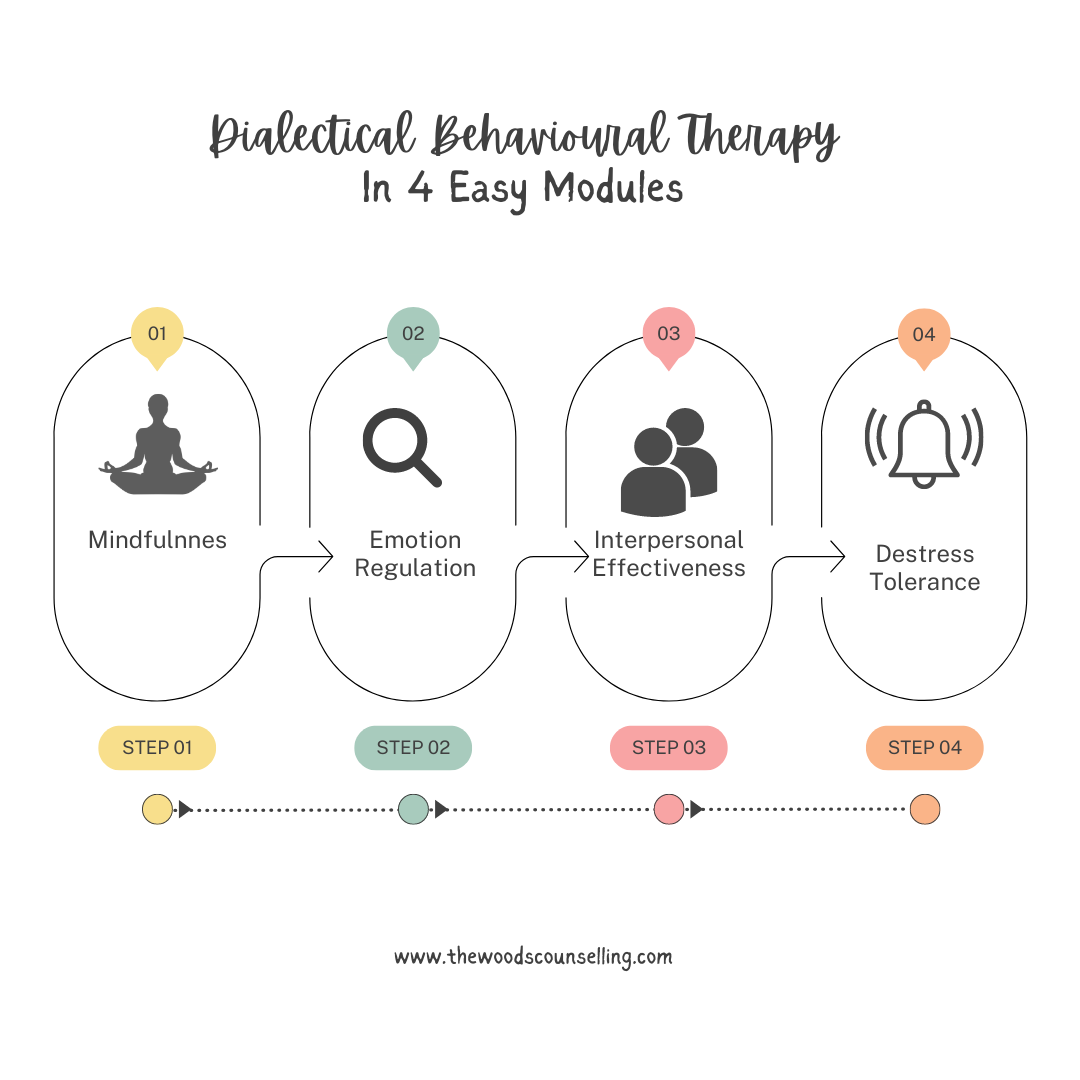
Welcome to The Woods Counselling
Better Health Blog
Here we offer insight on the best ways to approach trauma, and teach you the skills we’ve learned to handle chronic illness. And you’ll also find free counselling resources to put them into action.
search

Unpacking Trauma: Understanding the Difference Between Trauma and PTSD
Traumatic events can have a lasting impact on a person's mental and emotional well-being, but not everyone who experiences trauma goes on to develop PTSD. Understanding the difference between trauma and PTSD is crucial in seeking appropriate treatment.
Trauma can result in a range of symptoms, including depression, anxiety, panic, relationship difficulties, and more. Even if the symptoms do not meet the criteria for PTSD, it is still beneficial to work with a virtual therapist who has received additional training in trauma work and has a trauma-informed perspective. This type of therapist is best equipped to see the full picture of symptoms and address the impact of traumatic events on the body and nervous system, as well as the experience of dissociation.

How can DBT help with Chronic Pain?
How Is this applied to Chronic Pain Clients?
As noted by multiple researchers changing the order of DBT modules can make DBT more effective for chronic pain clients (Cavicchioli et al, 2021; Norman-Nott et al., 2021, Linehan, 2021, Linton, 2010; Reutter, 2021).
Most recommend beginning with emotion regulation and distress tolerance first as they are key to correcting skills deficits and treating disorders in this population.
Due to its flexible style of therapy it can be quite an affordable option for clients. This is important as many may be on disability due to their illness. Yet they can do DBT therapy through groups online, and virtual therapy, making it an affordable quality service for this population.

Interpersonal Effectiveness
Module on Interpersonal Effectiveness is to teach clients how to have skillful interaction in their relationships.
As many clients in DBT skills training groups want to improve the quality and quantity of their relationships, yet they often don’t have the tools to communicate effectively and increase assertiveness - which is why the DBT approach helps so much. We don’t all learn the skills we need for communication from our parents or teachers. And that’s why DBT assumes that clients are doing the best they can with the skills they have and may have areas where they can learn more.

What’s Emotion Regulation all About?
The emotion Regulation Module has been found to correct skills deficits and teach clients about the functions of their emotions.
DBT seeks to look at the factors that make up the clients emotional reaction through the use of chain analysis that is often used in CBT. And through the DBT treatment the aim is for better regulation of their emotions and the desired outcome of building a life worth living.
There are three parts to teaching emotion regulation, first helping clients to Understand and Naming Emotions. When we go over this we often bring in Brene Browns Emotions research as through her shame resilience research she has come up with beautiful descriptions. Then, in our virtual therapy sessions we proceed to teaching the Functions of each emotion, as often we don’t connect this. Using tools like videos and slide we discuss process these and use the model of emotions to break down the cognitive and behavioral parts. Lastly reviewing how clients can Observe describe, and name emotions as they arise. Part of this is teaching clients how emotions motivate their action urges.

Distress Tolerance
"A lot of clients come to therapy seeking solutions and strategies to solve problems that prompt pain and distress in their lives. The skills in the Distress Tolerance module have been designed with a different approach - as they are designed to help clients get through painful situations without adding additional pain." (Linehan, 2021)
Distress Tolerance is also part of the Acceptance side of the program, while the next two modules (i.e. emotion regulation and interpersonal effectiveness) focus on the change side of the therapy.
Skills taught in Distress tolerance are the following:
Distress Tolerance skills have two parts, crisis survival skills and radical acceptance skills.

Mindfulness Module
In Virtual Therapy we go over all the modules of DBT. And in the Mindfulness Module of DBT we focus on the practice of paying attention by focusing the mind (Linehan & Wilks, 2021). This helps clients to stay focused on one thing at a time. In the here and now.
Mindfulness Skills are central to DBT Skills as they are incorporated throughout all other modules. And there are three subsets of Mindfulness Skills that we go over,
1. The What skills are Characteristics of Mindfulness
2. The How skills Guide us on how to be mindful
3. Finding Wise Mind: is through teaching clients the dialectical balance of the Reasonable mind (rational/logical part), with the emotional mind which is the feelings and thoughts part.

How do You Use online therapy to go over DBT Modules?
In online therapy we go over the DBT four main skills modules: mindfulness, emotion regulation, distress tolerance, and interpersonal effectiveness. Through using new techniques like adding in slideshows, fun youtube videos and other technology to liven up the whole process.
"DBT has a modular structure, designed so that it's components can be dropped in and pulled out according to client needs. "(Norman-Nott et al., 2021). That means that these modules each can take a two-week timeframe to teach.

Basic Assumptions that therapist approach clients with in DBT
One of the core principles of dialectical behavior therapy (DBT) is the idea of basic assumptions. These are the beliefs that therapists hold about their clients and themselves when they engage in DBT.
The basic assumptions are:
The Basic Assumptions that therapist approach clients with when doing DBT is that:
1. all people are doing the best they can
2. That people want to improve
3. All people need to do better than they are, and try harder to be more motivated to change
4. People may not have caused all their problems but all people have to solve them anyway.
5. New behavior must be learned in all relevant contexts
6. All behaviors are caused
7. Figuring out and changing the cause of behavior is much more effective than trying to change by being judgmental and trying to blame others.
Want to learn more about virtual therapy and our online counselling services? Hit the button below!

What are the Goals of DBT
The big overarching goal of DBT is to help clients build lives that they experience as worth living. And using the life skills taught in DBT is a key factor in building that life. To do this DBT combines dialectical elements of both 1. Acceptance of reality and 2. Encouraging Change as we will review soon.
Though there are many dialectical assumptions in DBT. The main one is that clients are doing the best they can at any given moment in time. And also, that they must learn new behaviors in all relevant contexts. As skills don't always transfer between contexts.

What is DBT?
Our online therapist specializes in Virtual Dialectical Behavioral Therapy (dbt) which was originally developed by Marsha Linehan in 1993 to treat unremittent suicidal ideation and Borderline Personality Disorder (Meygoni & Ahadi, 2012). It is a subset of Cognitive Behavioral Therapy (cbt) and incorporates similar cognitive and behavioral strategies. In research studies, Linehan actively recruited the most severe, highly suicidal clients from their local areas and hospitals (Linehan et al., 1991). Through the development and teaching of this therapy style, there was a dramatic drop in depression levels and the majority returned to normal functioning.

What is an Attachment Style?
In relationship counselling we look at your attachment system. This is based on what happened growing up and your genetics. So, both nature and nurture combined to create how you unconsciously respond in relationship situations. This can have a big part to play in your therapy especially if your looking for: help with relationship issues, therapy for a breakup, therapist for abandonment issues, relationship anxiety counselling, etc.
The nurture part refers to both the environment and parenting styles you were raised with. Then, nature is based on how your genetic background plays a part. This means that your parent’s attachment styles can be passed down and be a factor in your likelihood towards each style.

Managing PTSD With Therapy
How Do You Start Virtual Therapy?
Picking A Therapist You Like And Feel Comfortable With.
Choosing a counsellor that fit's with you is important! This is because it will account for 30% of the therapeutic effect in your sessions. Also considering the therapist's qualifications. As one that has a master's in counselling has spent years studying psychology whereas others may not have. This is recommended the BC Association of Clinical Counselling. This means there will be an MA by their name. And lastly, it can be a good idea to choose one that specializes in trauma. This is for the same reason that you go to doctors that specialize in eyes, or ears. They may both understand how each part of the body works but the ear doctor works with ears everyday, and probably has extra education in that area.
2. Picking A Therapy Style That Lowers The Symptoms Of PTSD
Due to the large amount of research and evidence supporting CBT, it's strongly recommended as a first line treatment, over other variations of CBT or other therapy styles. The American Psychological Association has recommended this because it’s an approach that addresses all the symptoms through both thoughts and actions. This has been shown to have a strong effect on lowering symptoms in both acute stress disorder and post-traumatic stress disorder.


